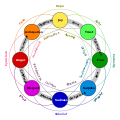References
- 1 2 3 Poria, Soujanya; Majumder, Navonil; Mihalcea, Rada; Hovy, Eduard (2019). "Emotion Recognition in Conversation: Research Challenges, Datasets, and Recent Advances". IEEE Access. 7: 100943–100953. arXiv: 1905.02947 . Bibcode:2019arXiv190502947P. doi:10.1109/ACCESS.2019.2929050. S2CID 147703962.
- ↑ Lee, Chul Min; Narayanan, Shrikanth (March 2005). "Toward Detecting Emotions in Spoken Dialogs". IEEE Transactions on Speech and Audio Processing. 13 (2): 293–303. Bibcode:2005ITSAP..13..293L. doi:10.1109/TSA.2004.838534. S2CID 12710581.
- ↑ Hazarika, Devamanyu; Poria, Soujanya; Zimmermann, Roger; Mihalcea, Rada (Oct 2019). "Emotion Recognition in Conversations with Transfer Learning from Generative Conversation Modeling". arXiv: 1910.04980 [cs.CL].
- ↑ Busso, Carlos; Bulut, Murtaza; Lee, Chi-Chun; Kazemzadeh, Abe; Mower, Emily; Kim, Samuel; Chang, Jeannette N.; Lee, Sungbok; Narayanan, Shrikanth S. (2008-11-05). "IEMOCAP: interactive emotional dyadic motion capture database". Language Resources and Evaluation. 42 (4): 335–359. doi:10.1007/s10579-008-9076-6. ISSN 1574-020X. S2CID 11820063.
- ↑ McKeown, G.; Valstar, M.; Cowie, R.; Pantic, M.; Schroder, M. (2012-01-02). "The SEMAINE Database: Annotated Multimodal Records of Emotionally Colored Conversations between a Person and a Limited Agent". IEEE Transactions on Affective Computing. 3 (1): 5–17. Bibcode:2012ITAfC...3....5M. doi:10.1109/t-affc.2011.20. ISSN 1949-3045. S2CID 2995377.
- ↑ Li, Yanran, Hui Su, Xiaoyu Shen, Wenjie Li, Ziqiang Cao, and Shuzi Niu. "DailyDialog: A Manually Labelled Multi-turn Dialogue Dataset." In Proceedings of the Eighth International Joint Conference on Natural Language Processing (Volume 1: Long Papers), pp. 986-995. 2017.
- ↑ Poria, Soujanya; Hazarika, Devamanyu; Majumder, Navonil; Naik, Gautam; Cambria, Erik; Mihalcea, Rada (2019). "MELD: A Multimodal Multi-Party Dataset for Emotion Recognition in Conversations". Proceedings of the 57th Annual Meeting of the Association for Computational Linguistics. Stroudsburg, PA, USA: Association for Computational Linguistics: 527–536. arXiv: 1810.02508 . doi:10.18653/v1/p19-1050. S2CID 52932143.
- ↑ Abdelwahab, Mohammed; Busso, Carlos (March 2005). "Supervised domain adaptation for emotion recognition from speech". 2015 IEEE International Conference on Acoustics, Speech and Signal Processing (ICASSP). pp. 5058–5062. doi:10.1109/ICASSP.2015.7178934. ISBN 978-1-4673-6997-8. S2CID 8207841.
{{cite book}}:|journal=ignored (help) - ↑ Chernykh, Vladimir; Prikhodko, Pavel; King, Irwin (Jul 2019). "Emotion Recognition From Speech With Recurrent Neural Networks". arXiv: 1701.08071 [cs.CL].
- ↑ Majumder, Navonil; Poria, Soujanya; Hazarika, Devamanyu; Mihalcea, Rada; Gelbukh, Alexander; Cambria, Erik (2019-07-17). "DialogueRNN: An Attentive RNN for Emotion Detection in Conversations". Proceedings of the AAAI Conference on Artificial Intelligence. 33: 6818–6825. arXiv: 1811.00405 . doi: 10.1609/aaai.v33i01.33016818 . ISSN 2374-3468.
- ↑ "Graph Convolutional Networks are Bringing Emotion Recognition Closer to Machines. Here's how". Tech Times. 2019-11-26. Retrieved February 25, 2020.
- ↑ Ghosal, Deepanway; Majumder, Navonil; Soujanya, Poria (Aug 2019). DialogueGCN: A Graph Convolutional Neural Network for Emotion Recognition in Conversation. Conference on Empirical Methods in Natural Language Processing (EMNLP).
- ↑ Jiao, Wenxiang; R. Lyu, Michael; King, Irwin (November 2019). "Real-Time Emotion Recognition via Attention Gated Hierarchical Memory Network". arXiv: 1911.09075 [cs.CL].
- 1 2 Poria, Soujanya; Majumder, Navonil; Hazarika, Devamanyu; Ghosal, Deepanway; Bhardwaj, Rishabh; Jian, Samson Yu Bai; Hong, Pengfei; Ghosh, Romila; Roy, Abhinaba; Chhaya, Niyati; Gelbukh, Alexander (2021-09-13). "Recognizing Emotion Cause in Conversations". Cognitive Computation. 13 (5): 1317–1332. arXiv: 2012.11820 . doi:10.1007/s12559-021-09925-7. ISSN 1866-9964. S2CID 229349214.

